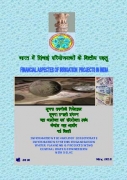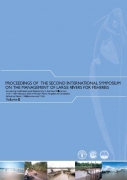Surface Water
Pampa Sarovara and its environs in Valmiki Ramayana - Paper presented at the National Seminar on Water and Culture (2007)
Posted on 14 Feb, 2011 03:17 AMThis paper describes a lake in one of the forests through which the Hindu god Ram and his brother Laxman passed, during their search for Sita. A virtual picture of the forest and the lake (Pampa Sarovara) in it using the Valmiki Ramayana which is a religious biopic of Ram's life on earth is created. This lake is situated near the town of Hampi in Karnataka today, and the forest is a rich source of water to this day.
Ideal historical river water use systems - Paper presented at the National Seminar on Water and Culture (2007)
Posted on 14 Feb, 2011 12:02 AMThe Phad system of irrigation which has been going on for centuries, is found in the northwestern parts of Maharashtra in the three river basins of Panjhra, Mosam, Kan and Aram. Weirs were constructed on these rivers to divert water for agriculture use. These weirs are locally called Bandhara. Each independent Phad system comprises of a diversion weir, a canal on the bank and distributor channels for irrigation.
Idol immersion activities and their management in water bodies in India - Paper presented at the National Seminar on Water and Culture (2007)
Posted on 13 Feb, 2011 11:07 PMThis paper begins with an analysis of the rationale for idol immersion in Hinduism. Some of the reasons given by the author include water being able to disintegrate idols, the idea of purity of water etc.
Irrigation in India - Management phases and its sustainability - Paper presented at the National Seminar on Water and Culture (2007)
Posted on 13 Feb, 2011 10:52 PMSince time immemorial water has been a common property and in many Indian communities there is deep reverence for flowing water. Using the flow of water for community benefit is considered an act of great merit and its misuse and contamination, a sin. In temples, tanks were constructed for rituals and also as a way to earn money for the temple.
Non-compliance of dam agencies in construction of hydro-electric projects in Himachal Pradesh - A photo-essay by SANDRP
Posted on 13 Feb, 2011 03:02 PM
Download the photo essay:
Financial aspects of irrigation projects in India – A report by the Central Water Commission
Posted on 13 Feb, 2011 08:28 AM This publication by the Central Water Commission presents data on Major and Medium Irrigation and Multipurpose projects, Minor Irrigation projects, Command Area Development scheme as available in the Finance A
This publication by the Central Water Commission presents data on Major and Medium Irrigation and Multipurpose projects, Minor Irrigation projects, Command Area Development scheme as available in the Finance A
International ReSource Award for Sustainable Watershed Management 2012 - Swiss Re - Deadline 30 April 2011
Posted on 08 Feb, 2011 03:31 PMThe International ReSource Award is worth USD 150 000 in total and is granted to one or several projects selected by an international jury. Launched in 2002, the ReSource award is an internationally recognised prize for leadership in implementing the principles of sustainability in watershed management. It is conferred annually. The prize money is awarded exclusively for project implementation activities and not for building-up or strengthening the organizations that are submitting an application.
Eligibility to participate:
NGOs, private, scientific or public institutions and similar bodies are invited to participate in the tender for the International ReSource award for Sustainable Watershed Management. Projects comprising more than one institution (eg public-private
Latest status of the storage of important reservoirs in the country - CWC - PIB Release
Posted on 05 Feb, 2011 12:17 PMOf these, as many as 36 reservoirs are having significant hydro-power benefits with installed capacities of more than 60MW each. The combined live storage in these 81 reservoirs at the beginning of monsoon, i.e. June 1, 2010 was 14% of their designed capacity and stood at 60% of designed capacity as on January 27, 2011. The present storage is 137% of last year’s storage and 145% of last 10 years average storage during the same period. Out of these 81 reservoirs there are presently 15 reservoirs where this year’s storage is less than 80 % of the average of previous 10 years and in remaining 66 reservoirs the storage is more than 80% of the average of previous 10 years.
Wetlands (Conservation and Management) Rules 2010 - Welcome, but a lost opportunity - Press release by SANDRP
Posted on 04 Feb, 2011 10:33 AMOn the occasion of the World Wetlands Day 2011, while we welcome the notification of Wetland (Conservation and Management) rules 2010 by the Union Ministry of Env
Proceedings of the second international symposium on the management of large rivers for fisheries by FAO and Mekong River Commission
Posted on 03 Feb, 2011 07:55 PM The second international symposium on the management of large rivers for fisheries was held by the Food and Agriculture Organisation of the United Nations (FAO) and Mekong River Commission on 11 - 14 February 2003 in Phnom Penh, Kingdom of Cambodia. It had three primary objectives: (a) To provide a forum to review and synthesise the latest information on large rivers; (b) To raise the political, public and scientific awareness of the importance of river systems, the living aquatic resources they support and the people that depend on them; and (c) To contribute to better management, conservation and restoration of the living aquatic resources of large rivers.
The second international symposium on the management of large rivers for fisheries was held by the Food and Agriculture Organisation of the United Nations (FAO) and Mekong River Commission on 11 - 14 February 2003 in Phnom Penh, Kingdom of Cambodia. It had three primary objectives: (a) To provide a forum to review and synthesise the latest information on large rivers; (b) To raise the political, public and scientific awareness of the importance of river systems, the living aquatic resources they support and the people that depend on them; and (c) To contribute to better management, conservation and restoration of the living aquatic resources of large rivers.
The symposium was organised in six sessions:
Session 1: Status of rivers
Session 2: Value of river fisheries
Session 3: Fisheries ecology and conservation
Session 4: Management of river fisheries
Session 5: Statistics and information
Session 6: Synthesis
It came up with the following recommendations for action -
- Improve the valuation of living river resources in order to contribute to equitable and sustainable management of fishery resources and properly place the fishery in the context of the other uses of rivers.
- Direct greater effort to better understanding the social and economic aspects of fisheries to support policy and management priorities; livelihood approaches will be a valuable tool.
- Communicate and engage with environment and water resources managers within the context of multi-use of water in order to accurately assess impacts and to sustain the benefits of river fisheries in an equitable manner.
- Develop processes that facilitate the users and beneficiaries of the fishery resource to assume greater control of its management.
- Establish appropriate mechanisms at national and basin level to enable negotiation for the needs of communities dependent upon the living aquatic resources. In particular further regulations need to be elaborated to protect general ecosystem function and provide for environmental flows.
- Use instruments such as the freshwater eco-regions approach, the Ramsar Convention and the guidelines for water allocation suggested by the World Commission on Dams, to enhance planning for conservation and sustainable use of river habitats.
- Incorporate ecological flow requirements of river-floodplain systems into development plans and impact assessments that affect river flows, taking into account the seasonality of the system and the environmental cues needed by the fish for migration and reproduction.
- Rehabilitate degraded ecosystems wherever possible. Prioritize schemes that ensure connectivity and protection of critical habitats.





